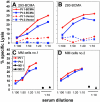Graft-versus-tumor response in patients with multiple myeloma is associated with antibody response to BCMA, a plasma-cell membrane receptor
- PMID: 15692072
- PMCID: PMC1895080
- DOI: 10.1182/blood-2004-11-4463
Graft-versus-tumor response in patients with multiple myeloma is associated with antibody response to BCMA, a plasma-cell membrane receptor
Abstract
Donor lymphocyte infusions (DLIs) induce effective graft-versus-tumor responses in patients with multiple myeloma who relapse after allogeneic hematopoietic stem-cell transplantation. The graft-versus-myeloma response is presumably mediated primarily by donor T cells, but recent studies have also demonstrated the presence of antibodies specific for a variety of myeloma-associated antigens in patients who achieve complete remission after DLI. One of the B-cell antigens identified in these studies was B-cell maturation antigen (BCMA), a transmembrane receptor of the tumor necrosis factor (TNF) superfamily that is selectively expressed by mature B cells. The present studies were undertaken to characterize the functional significance of antibodies to BCMA in vivo. Using transfected cells expressing BCMA, antibodies in patient serum were found to react with the cell-surface domain of BCMA. Post-DLI patient serum was able to induce complement-mediated lysis and antibody-dependent cellular cytotoxicity (ADCC) of transfected cells and primary myeloma cells expressing BCMA. BCMA antibodies were only found in post-DLI responders and not in other allogeneic transplant patients or healthy donors. These results demonstrate that BCMA is a target of donor B-cell immunity in patients with myeloma who respond to DLI. Antibody responses to cell-surface BCMA may contribute directly to tumor rejection in vivo.
Figures





References
-
- Bensinger WI, Buckner CD, Anasetti C, et al. Allogeneic marrow transplantation for multiple myeloma: an analysis of risk factors on outcome. Blood. 1996;88: 2787-2793. - PubMed
-
- Bellucci R, Ritz J. Allogeneic stem cell transplantation for multiple myeloma. Rev Clin Exp Hematol. 2002;6: 205-224. - PubMed
-
- Alyea EP, Soiffer RJ, Canning C, et al. Toxicity and efficacy of defined doses of CD4(+) donor lymphocytes for treatment of relapse after allogeneic bone marrow transplant. Blood. 1998;91: 3671-3680. - PubMed
-
- Lokhorst HM, Schattenberg A, Cornelissen JJ, et al. Donor lymphocyte infusions for relapsed multiple myeloma after allogeneic stem-cell transplantation: predictive factors for response and long-term outcome. J Clin Oncol. 2000;18: 3031-3037. - PubMed
-
- Horowitz MM, Gale RP, Sondel PM, et al. Graftversus-leukemia reactions after bone marrow transplantation. Blood. 1990;75: 555-562. - PubMed
Publication types
MeSH terms
Substances
Grants and funding
LinkOut - more resources
Full Text Sources
Other Literature Sources
Medical
Research Materials

